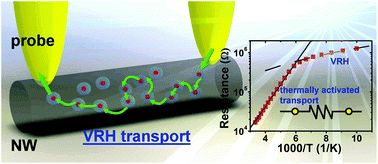Electron transport in high-resistance semiconductor nanowires through two-probe measurements
Abstract
Since the successful fabrication of semiconductor

* Corresponding authors
a
Department of Electrophysics, National Chiao Tung University, Hsinchu 30010, Taiwan
E-mail:
wbjian@mail.nctu.edu.tw
b Department of Engineering and System Science, National Tsing Hua University, Hsinchu 30013, Taiwan
c Department of Chemistry, State University of New York at Binghamton, Binghamton, New York 13902-6000, USA
Since the successful fabrication of semiconductor

 Please wait while we load your content...
Something went wrong. Try again?
Please wait while we load your content...
Something went wrong. Try again?
Y. Lin, T. Chen, C. Chang, Y. Chang, Y. Chiu, H. Hung, J. Kai, Z. Liu, J. Fang and W. Jian, Phys. Chem. Chem. Phys., 2010, 12, 10928 DOI: 10.1039/C0CP00038H
To request permission to reproduce material from this article, please go to the Copyright Clearance Center request page.
If you are an author contributing to an RSC publication, you do not need to request permission provided correct acknowledgement is given.
If you are the author of this article, you do not need to request permission to reproduce figures and diagrams provided correct acknowledgement is given. If you want to reproduce the whole article in a third-party publication (excluding your thesis/dissertation for which permission is not required) please go to the Copyright Clearance Center request page.
Read more about how to correctly acknowledge RSC content.
 Fetching data from CrossRef.
Fetching data from CrossRef.
This may take some time to load.
Loading related content
